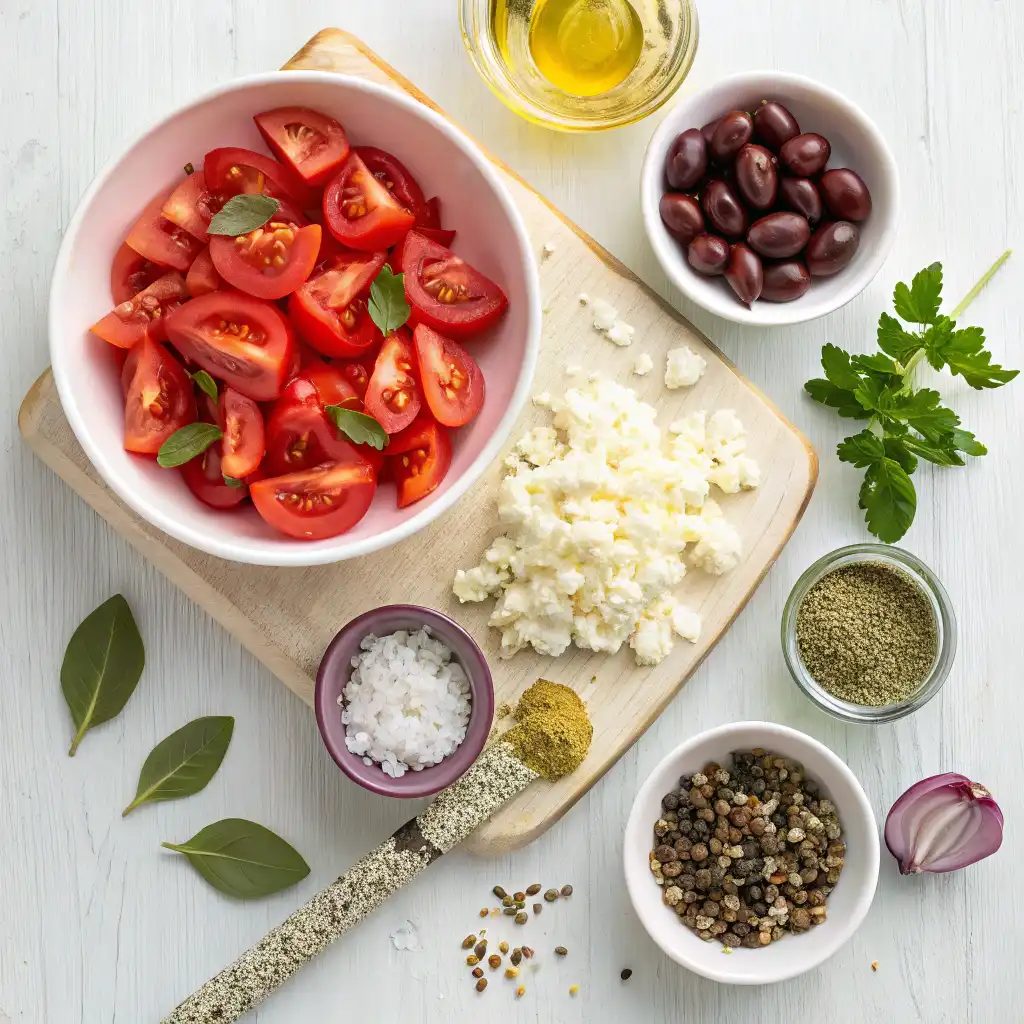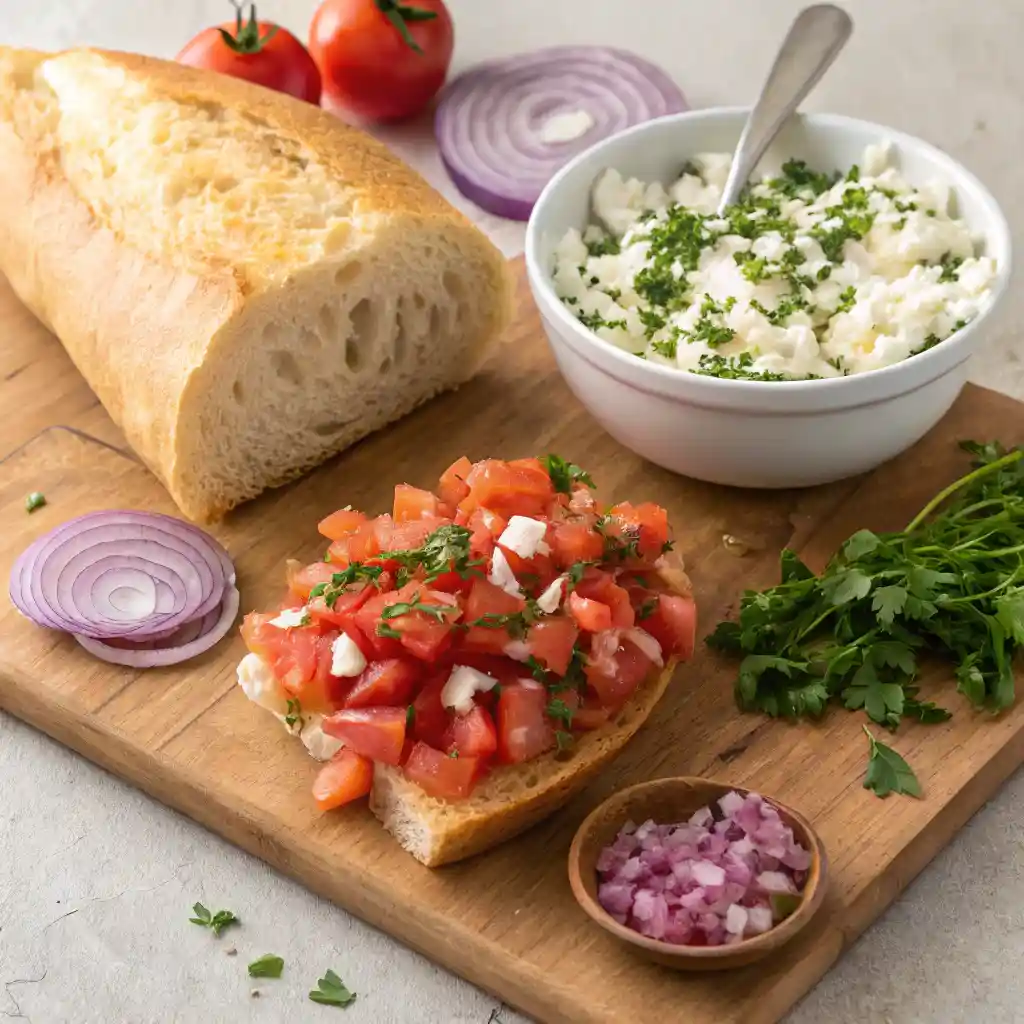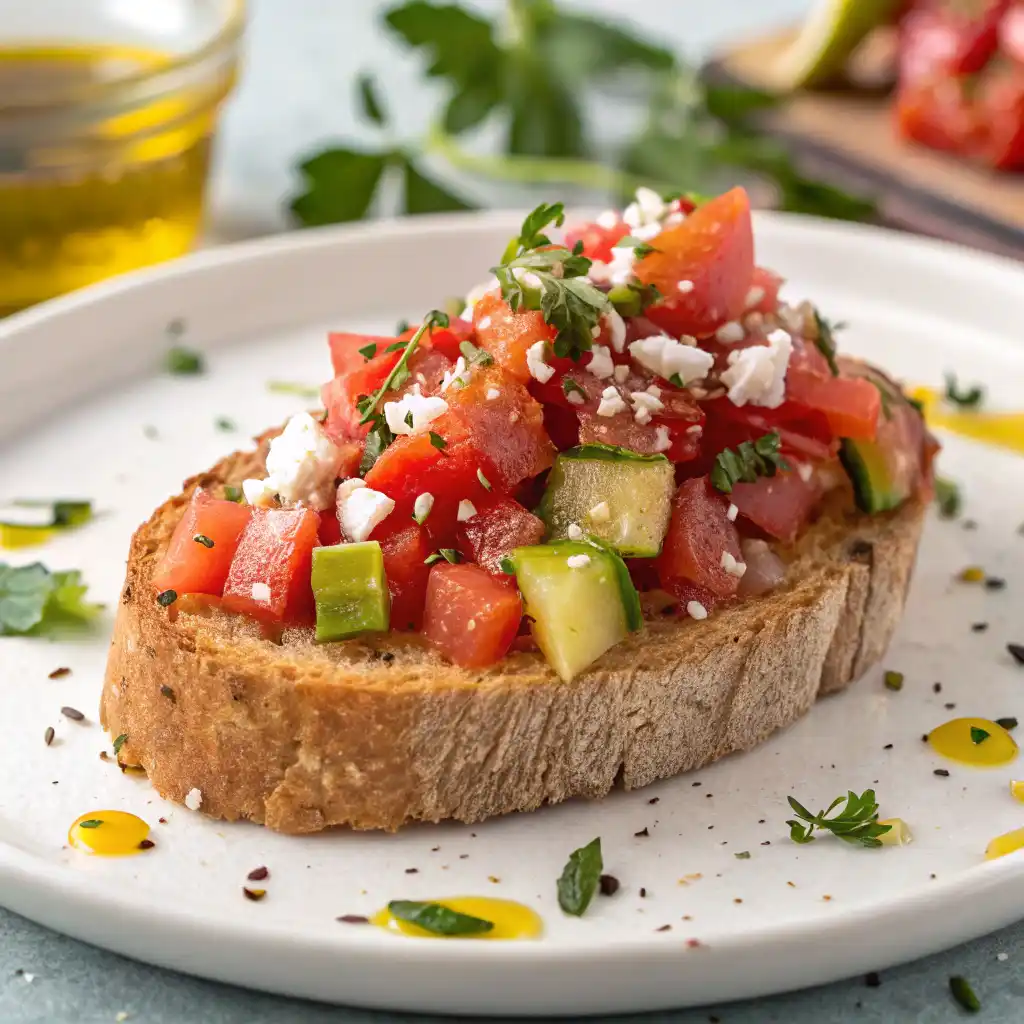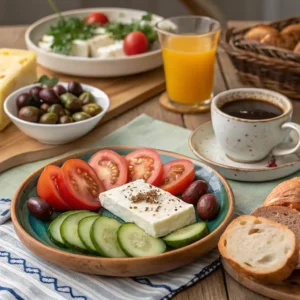Table of Contents
Imagine biting into a perfect harmony of textures crispy rusks topped with juicy tomatoes, creamy feta, and a drizzle of liquid gold olive oil. That’s the magic of Dakos, Crete’s answer to Italy’s bruschetta, but with its own Mediterranean soul! This 10-minute wonder has been my summer go-to for years, especially when the tomatoes are bursting with sunshine flavor. What makes Dakos truly special is how something so simple can deliver such complex flavors without keeping you hostage in the kitchen.
I first discovered this traditional Cretan meze during a seaside vacation where locals served it as a casual appetizer before dinner. The combination of textures—the satisfying crunch giving way to the cool, fresh toppings—creates an experience that’s greater than the sum of its humble parts. Unlike my Greek Moussaka recipe that requires an hour of preparation, Dakos delivers authentic Greek flavors with practically zero cooking time.
The beauty of Dakos lies in its authenticity—it’s not a watered-down adaptation but a genuine peasant dish that has sustained Cretan shepherds and farmers for generations. Once you master this simple recipe, you’ll have an impressive Mediterranean appetizer in your culinary arsenal that’s perfect for everything from solo snacking to entertaining guests who will think you’ve spent hours in the kitchen!
What is Dakos recipe ?
Ever wondered what would happen if bruschetta went on a Greek vacation and never came back? Meet Dakos! This Cretan delight (pronounced “DAH-kohs”) is essentially what happens when hardened bread decides to dress up in Mediterranean finery. Named after the barley rusks that form its base, this dish has been sustaining Greek islanders long before “Mediterranean diet” became a trendy hashtag. Legend has it that these rusks were originally created to help sailors and shepherds preserve bread during long journeys—talk about practical deliciousness! As the old saying goes, “the way to a man’s heart is through his stomach,” and I can guarantee that this humble peasant dish will win hearts faster than you can say “opa!” Ready to transport your taste buds to the shores of Crete without the airfare? Let’s dive in!
Why You’ll Love This Dakos Recipe:
This Dakos recipe is a game-changer for anyone looking to bring authentic Mediterranean flavors to their table with minimal effort. The star of the show is undoubtedly the contrast between the crunchy barley rusk base and the juicy tomato topping—a textural experience that makes each bite more satisfying than the last. Your teeth break through the softened crust into a garden of fresh flavors that dance on your palate.
Making Dakos at home is incredibly cost-effective compared to ordering it at a Greek restaurant. For less than $10, you can create multiple servings of this premium appetizer that would easily cost $15-20 per plate at a taverna. The rusks might require a special trip to a Mediterranean market, but they’re inexpensive and last practically forever in your pantry.
The combination of sun-ripened tomatoes, creamy feta, aromatic oregano, and rich olive oil creates a flavor profile that’s both bold and harmonious. Unlike my Greek Salad recipe, which relies on similar ingredients but in different proportions, Dakos offers a more substantial bite while still maintaining that fresh Mediterranean essence. Once you try this recipe, I guarantee you’ll be adding it to your regular rotation of quick meals and impressive appetizers. Why not give it a try tonight?
How to Make Dakos recipe:
Quick Overview
This Cretan classic comes together in just 10 minutes, making it perfect for busy weeknights or last-minute entertaining. What makes Dakos so special is how the moisture from the tomatoes gently softens the rusks without making them soggy, creating that perfect balance between crunch and tenderness. The entire recipe requires zero cooking, just some simple chopping and assembling, making it accessible even to kitchen novices. From start to finish, you’ll spend less than 10 minutes active time, and you’ll have an authentic Mediterranean appetizer that looks like it came from a seaside taverna.
Key Ingredients for Dakos Recipe:

- 4 Cretan barley rusks (paximadia) or substitute with thick, crusty bread toasted until very hard
- 4 medium ripe tomatoes, grated or finely chopped
- 200g feta cheese, crumbled
- 1/2 cup Kalamata olives, pitted and roughly chopped (optional)
- 2 tablespoons capers, drained (optional)
- 1 small red onion, finely diced
- 4 tablespoons extra virgin olive oil (use the best quality you can find)
- 1 tablespoon dried oregano
- 1 teaspoon dried thyme (optional)
- Salt and freshly ground black pepper to taste
- Fresh basil leaves for garnish (optional)
Step-by-Step Instructions Dakos recipe :

- Prepare the rusks: If the barley rusks are very hard (as they should be), sprinkle each with a little water or run quickly under the tap. The goal is to slightly soften them without making them soggy. Place them on serving plates.
- Prepare the tomatoes: Grate the tomatoes using a box grater over a bowl to catch all the juices, or finely chop them. Discard the skins if grating. Season the tomato mixture with a pinch of salt.
- Assemble the base: Spoon the tomato mixture generously over each rusk, making sure to include some of the tomato juice which will further soften the rusks. Let sit for 1-2 minutes to allow the rusks to absorb some moisture.
- Add the cheese: Crumble the feta cheese evenly over the tomato layer on each rusk.
- Add the remaining toppings: Sprinkle the chopped red onion, olives, and capers (if using) over the feta layer.
- Finish with seasonings: Drizzle each Dakos generously with olive oil, then sprinkle with dried oregano, thyme, and a crack of fresh black pepper. No additional salt is usually needed as the feta and capers are already salty.
- Garnish and serve: Add a few fresh basil leaves if desired, and serve immediately while the rusks still maintain some crunch around the edges.
What to Serve Dakos recipe With:
Dakos works beautifully as part of a larger Greek meze spread or as a light meal on its own. For a complete Mediterranean experience, pair it with a Greek salad for fresh contrast or some grilled halloumi cheese for a more substantial appetizer course. A simple cucumber tzatziki provides a cool, creamy accompaniment that balances the rustic crunch of the Dakos.
For beverages, nothing complements Dakos better than a glass of crisp white wine—particularly a Greek Assyrtiko from Santorini with its mineral notes or a light Moschofilero from the Peloponnese. If you’re keeping things non-alcoholic, a sparkling water with a squeeze of lemon captures the refreshing Mediterranean spirit.
For a more substantial meal, serve Dakos alongside grilled fish dressed simply with lemon and herbs, or with Greek-style lemon roasted potatoes. The freshness of the Dakos contrasts beautifully with these warmer, heartier dishes, creating a balanced meal that feels like a seaside taverna experience at home.
Top Tips for Perfecting Dakos recipe :
Finding the right balance of moisture is crucial for perfect Dakos. If your rusks are exceptionally hard, sprinkle them with a bit more water or tomato juice, but be patient let them sit for 2 a 3 minutes to soften rather than over-soaking them and risking a soggy mess. Conversely, if using substitute bread like toasted baguette, you may want to toast it longer than you normally would to achieve the traditional firm base.
The quality of your olive oil makes a tremendous difference in this simple recipe. This is the time to use that special bottle of extra virgin olive oil you’ve been saving its fruity, peppery notes will elevate the entire dish. For an authentic touch, look for Cretan olive oil if available.
Don’t skip the step of salting your tomatoes before adding them to the rusks. This not only seasons them but also helps draw out their juices, creating that flavorful liquid that will transform the rusks. For the best flavor, make Dakos during peak tomato season (late summer to early fall) when tomatoes are at their most flavorful. If making Dakos outside tomato season, consider using cherry tomatoes, which tend to be sweeter year-round.
For those who can’t find traditional barley rusks, suitable substitutes include twice-baked bread (biscotti-style), very well-toasted sourdough, or even thick pita bread toasted until very crisp. Just remember that authentic Dakos has a substantial crunch, so whatever substitute you choose should be robust enough to hold the toppings without immediately falling apart.
Storing and Reheating Tips:
Dakos is best enjoyed immediately after assembly as the rusks continue to soften over time. However, if you find yourself with leftovers, store the components separately whenever possible. Keep any unused rusks in an airtight container at room temperature where they’ll stay fresh for months.
The tomato topping mixture (without the feta) can be refrigerated in an airtight container for up to 2 days. Store the crumbled feta separately in its own container. If you’ve already assembled the complete Dakos and need to store leftovers, place them in the refrigerator for up to 24 hours, though be aware the texture will be significantly softer.
Dakos isn’t ideal for freezing as the tomatoes and rusks would both suffer texturally. For reheating already-assembled leftovers, a few minutes in a 300°F (150°C) oven can help restore some crispness to the base, though it won’t match the freshly prepared version. For the most authentic experience, I recommend preparing only what you plan to eat immediately and assembling fresh Dakos when needed—thankfully, with a 10-minute preparation time, this isn’t much hardship!
For more Greek recipes, visit this link : Ultimate Guide to Greek Breakfast
Can I make Dakos if I can’t find traditional Cretan barley rusks?
Absolutely! While authentic Cretan barley rusks (paximadia) provide the traditional base, you can substitute with several alternatives. Twice-baked bread, very well-toasted sourdough, or even toasted pita bread can work. The key is ensuring whatever bread you use is toasted until very firm and crunchy. A thick slice of country bread toasted in a low oven (around 250°F) for 15-20 minutes until hard throughout makes an excellent substitute. Remember that the bread needs to be sturdy enough to hold the juicy toppings without immediately becoming soggy.
How do I know if I’ve added the right amount of moisture to the rusks?
Finding the perfect moisture balance is crucial for Dakos. The rusks should be slightly softened while maintaining some crunch around the edges. When you sprinkle water on the rusks, aim to moisten them just enough that they’re no longer rock-hard—about 1-2 teaspoons of water per rusk is typically sufficient. After adding the tomato mixture, wait 1-2 minutes before taking your first bite. The rusks should yield when bitten but still offer some resistance. If they remain too hard after this time, you can drizzle a little more tomato juice over them. If they become too soft and fall apart easily, you’ve added too much moisture and should use less water next time.
. Can I prepare Dakos in advance for a party?
Dakos is best enjoyed freshly assembled, as the rusks gradually soften over time. For parties, consider preparing all components separately ahead of time: grate the tomatoes and store them in a container (with their juice), crumble the feta, chop the onions and herbs, and keep the rusks dry. Set up a “Dakos station” where guests can assemble their own, or prepare them no more than 15-20 minutes before serving. If you must fully assemble them further in advance, prepare the rusks with just a light sprinkle of water, then add the toppings no more than 30 minutes before serving to maintain the best texture balance between softened yet still slightly crunchy.




